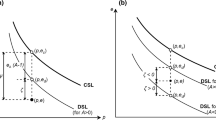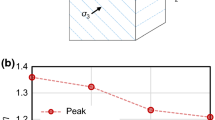Abstract
This paper proposes a new constitutive model within the recent anisotropic critical state theory (ACST) to take into account the influence of evolving fabric on the stress–strain–strength response of anisotropic sands. Analytical proofs in support of stress–force–fabric correlations corroborate a clear connection between mobilization of the continuum level stress ratio and particle level fabric in granular media. A normalized stress ratio-dependent second-order fabric tensor is suggested here which fulfills the ACST. Dilatancy and plastic hardening modulus of a stress ratio-driven elastoplastic model with zero pure elastic domain are explicitly interrelated to the proposed stress ratio-dependent normalized fabric tensor. It is shown that the fabric-dependent model simulations agree well with the monotonic triaxial and hollow cylinder torsion shear tests data.










Similar content being viewed by others

References
Alipour MJ, Lashkari A (2018) Sand instability under constant shear drained stress path. Int J Solids Struct 150:66–82
Azami A, Pietruszczak S, Guo P (2010) Bearing capacity of shallow foundations in transversely isotropic granular media. Int J Numer Anal Methods Geomech 34(8):771–793
Been K, Jefferies MG (1985) A state parameter for sands. Géotechnique 35(2):99–112
Dafalias YF (2016) Must critical state theory be revisited to include fabric effects? Acta Geotech 11(3):479–491
Dafalias YF, Papadimitriou AG, Li XS (2004) Sand plasticity model accounting for inherent fabric anisotropy. J Eng Mech 130(11):1319–1333
Einav I, Puzrin A (2004) Pressure-dependent elasticity and energy conservation in elastoplastic models for soils. J Geotech Geoenviron Eng 130(1):81–92
Farhadi B, Lashkari A (2017) Influence of soil inherent anisotropy on behavior of crushed sand-steel interfaces. Soils Found 57(1):111–125
Finn WDL (2000) Post-liquefaction flow deformations. In: Pak RYS, Yamamura J (eds) Soil dynamics and liquefaction 2000. Geotechnical special publication no. 107, pp 108–122
Fu PC, Dafalias YF (2011) Study of anisotropic shear strength of granular materials using DEM simulation. Int J Numer Anal Methods Geomech 35:1098–1126
Gao Z, Zhao J, Li XS, Dafalias YF (2014) A critical state sand plasticity model accounting for fabric evolution. Int J Numer Anal Methods Geomech 38(4):370–390
Golchin A, Lashkari A (2014) A critical state sand model with elastic-plastic coupling. Int J Solids Struct 51:2807–2825
Graham J, Houlsby GT (1983) Anisotropic elasticity of a natural clay. Géotechnique 33(2):165–180
Gu X, Huang M, Qian J (2014) DEM investigation on the evolution of microstructure in granular soils under shearing. Granular Matter 16:91–106
Guo N, Zhao J (2013) The signature of shear-induced anisotropy in granular media. Comput Geotech 47:1–15
Gutierrez M, Ishihara K, Towhata I (1991) Flow theory for sand during rotation of principal stress direction. Soils Found 31(4):121–132
Hardin BO, Richart FE (1963) Elastic wave velocities in granular soils. J Soil Mech Found Eng Div 89(SM1):33–65
Imseeh WH, Druckrey AM, Alshibli KA (2018) 3D experimental quantification of fabric and fabric evolution of sheared granular materials using synchrotron micro-computed tomography. Granular Matter 20:24. https://doi.org/10.1007/s10035-018-0798-x
Jiang M, Zhang A, Fu C (2018) 3-D DEM simulation of drained triaxial tests on inherently anisotropic granulates. Eur J Environ Civ Eng 22:37–56
Koseki J, Kawakami S, Nagayama H, Sato T (2000) Change of small strain quasielastic deformation properties during undrained cyclic torsional shear and triaxial tests of Toyoura sand. Soils Found 40(3):101–110
Lade PV, Duncan JM (1973) Cubical triaxial tests on cohesionless soils. J Soil Mech Found Eng 99(SM10):793–812
Lashkari A (2010) A SANISAND model with anisotropic elasticity. Soil Dyn Earthq Eng 30(146):2–1477
Lashkari A (2016) Prediction of flow liquefaction instability of clean and silty sands. Acta Geotech 11(5):987–1014
Lashkari A, Golchin A (2014) On the influence of elastic-plastic coupling on sands response. Comput Geotech 55:352–364
Lashkari A, Jamali V (2020) Global and local sand-geosynthetic interface behavior. Geétechnique. https://doi.org/10.1680/jgeot.19.P.109
Lashkari A, Yaghtin MS (2018) Sand flow liquefaction instability under shear-volume coupled strain paths. Géotechnique 68(11):1002–1024
Lashkari A, Karimi A, Fakharian K, Kaviani-Hamedani F (2017) Prediction of undrained behavior of isotropically and anisotropically consolidated Firoozkuh sand: instability and flow liquefaction. Int J Geomech 17(10):04017083-1–04017083-17
Lashkari A, Khodadadi M, Binesh SM, Rahman MdM (2019) Instability of particulate assemblies under constant shear drained stress path: a DEM approach. Int J Geomech 19(6):04019049-1–04019049-21
Li XS, Dafalias YF (2000) Dilatancy for cohesionless soils. Géotechnique 50(4):449–460
Li XS, Dafalias YF (2002) Constitutive modeling of inherently anisotropic sand behavior. J Geotech Geoenviron Eng 128(10):868–880
Li XS, Dafalias YF (2012) Anisotropic critical state theory: role of fabric. ASCE J Eng Mech 138(3):263–275
Li X, Yu H-S (2013) On the stress-force-fabric relationship for granular materials. Int J Solids Struct 50:1285–1302
Li X, Yu H-S, Li XS (2009) Macro-micro relations in granular mechanics. Int J Solids Struct 46(25–26):4331–4341
Li B, Zeng X, Ming H (2010) Seismic response of retaining wall with anisotropic backfills. In: ASCE geotechnical special publication 384 (proceedings of earth retention conference), Reston, VA, USA, pp 688–695
Mehrabadi MM, Nemat-Nasser S, Oda M (1982) On statistical description of stress and fabric in granular materials. Int J Numer Anal Methods Geomech 6:95–108
Nakata Y, Hyodo M, Murata H, Yasufuku N (1998) Flow deformation of sands subjected to principal stress rotation. Soils Found 38(2):115–128
Oda M (1972) The mechanism of fabric changes during compressional deformation of sand. Soils Found 12(2):1–18
Oda M (1993) Inherent and induced anisotropy in plasticity theory of granular soils. Mech Mater 16:35–45
Oda M (1999) Fabric tensor and its geometrical meaning. In: Oda M, Iwashita K (eds) Introduction to mechanics of granular materials. AA Balkema, Rotterdam, pp 27–35
Oda M, Koishikawa I (1979) Effect of strength anisotropy on bearing capacity of shallow footing in a dense sand. Soils Found 19(3):15–28
Papadimitriou AG, Dafalias YF, Yoshimine M (2005) Plasticity modeling of the effect of sample preparation method on sand response. Soils Found 45(2):109–123
Papadimitriou AG, Chaloulos YK, Dafalias YF (2018) A fabric-based sand plasticity model with reversal surfaces within anisotropic critical state theory. Acta Geotech. https://doi.org/10.1007/s11440-018-751-5
Petalas AL, Dafalias YF, Papadimitriou AG (2018) SANISAND-FN: an evolving fabric-based sand model accounting for stress principal axes rotation. Int J Numer Anal Methods Geomech. https://doi.org/10.1002/nag.2855
Qin J, Zeng X, Ming H (2016) Centrifuge modeling and the influence of fabric anisotropy on seismic response of foundations. J Geotech Geoenviron Eng 142(3):1–11
Rahman MM, Baki MAL, Lo SR (2014) Prediction f undrained monotonic and cyclic liquefaction of sand with fines based on the equivalent granular state parameter. Int J Geomech 14(2):254–266
Roscoe KH, Schofield AN, Wroth CP (1958) On the yielding of soils. Géotechnique 8(1):22–53
Salimi MJ, Lashkari A (2020) Undrained true triaxial response of initially anisotropic particulate assemblies using CFM-DEM. Comput Geotech 124:103509
Seed HB, Seed RB, Harder Jr LF, Jong H-L (1989) Re-evaluation of the lower Sand Fernando dam. Report no. 2, examination of the post-earthquake slide of February 9, 1971, Department of the Army, US Army Corps of Engineers, Washington, DC 20314-1000
Seyedi Hosseininia E (2012) Investigating the micromechanical evolutions within inherently anisotropic granular materials using discrete element method. Granular Matter 14(4):483–503
Seyedi Hosseininia E (2013) Stress-force-fabric relationship for planar granular materials. Géotechnique 63(10):830–841
Shi J, Guo P (2018) Fabric evolution of granular materials along imposed stress paths. Acta Geotech. https://doi.org/10.1007/s11440-018-0665-2
Sivathayalan S, Vaid YP (2002) Influence of generalized initial state and principal stress rotation on the undrained response of sands. Can Geotech J 39:63–76
Sun Y, Gao Y, Zhu Q (2018a) Fractional order plasticity modeling of state-dependent behavior of granular soils without using plastic potential. Int J Plast 102:53–69
Sun Y, Gao Y, Shen Y (2018b) Mathematical aspect of the state-dependent stress-dilatancy of granular soils under triaxial loading. Géotechnique. https://doi.org/10.1680/jgeot.17.T.029
Theocharis AI, Vairaktaris E, Dafalias YF, Papadimitriou AG (2016) Proof of incompleteness of critical state theory in granular mechanics and its remedy. J Eng Mech 143(2):04016117-1–04016117-12
Uthayakumar M, Vaid YP (1998) Static liquefaction of sands under multiaxial loading. Can Geotech J 35:273–283
Vaid YP, Sivathayalan S (2000) Fundamental factors affecting liquefaction susceptibility of sands. Can Geotech J 37:592–606
Verdugo R, Ishihara K (1996) Steady state of sandy soil. Soils Found 36(2):81–91
Wang Z-L, Dafalias YF, Shen X-K (1990) Bounding surface hypoplasticity model for sand. ASCE J Eng Mech 116(5):983–1001
Xiao Y, Liu H (2017) Elastoplastic constitutive model for rockfill materials considering particle breakage. ASCE Int J Geomech 17(1):04016041-1–04016041-13
Yang ZX, Wu Y (2016) Critical state for anisotropic granular materials: a discrete element perspective. Int J Geomech 17(2):04016054-1–04016054-15
Yang ZX, Li XS, Yang J (2008) Quantifying and modeling fabric anisotropy of granular soils. Géotechnique 58(4):237–248
Yoshimine M, Ishihara K, Vargas W (1998) Effects of principal stress direction and intermediate principal stress on undrained shear behavior of sand. Soils Found 38(3):179–188
Zhao J, Gao Z (2015) Unified anisotropic elastoplastic model for sand. J Eng Mech 142(1):04015056-1–04015056-12
Zheng J, Hryciw RD (2018) Cross-anisotropic fabric of sands by wavelet-based simulation of human cognition. Soils Found 58(4):1028–1041
Author information
Authors and Affiliations
Corresponding author
Rights and permissions
About this article
Cite this article
Norouzi, N., Lashkari, A. An Anisotropic Critical State Plasticity Model with Stress Ratio-Dependent Fabric Tensor. Iran J Sci Technol Trans Civ Eng 45, 2577–2594 (2021). https://doi.org/10.1007/s40996-020-00448-z
Received:
Accepted:
Published:
Issue Date:
DOI: https://doi.org/10.1007/s40996-020-00448-z



